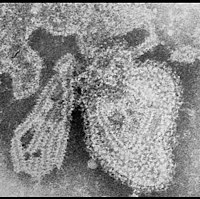
Photo from wikipedia
Understanding of mumps virus (MuV) pathogenesis and the immune responses against MuV infection is limited. One of the reasons is the lack of relevant animal models. ABSTRACT Mumps is a… Click to show full abstract
Understanding of mumps virus (MuV) pathogenesis and the immune responses against MuV infection is limited. One of the reasons is the lack of relevant animal models. ABSTRACT Mumps is a highly contagious viral disease that can be prevented by vaccination. In the last decade, we have encountered repeated outbreaks of mumps in highly vaccinated populations, which call into question the effectiveness of available vaccines. Animal models are crucial for understanding virus-host interactions, and viruses such as mumps virus (MuV), whose only natural host is the human, pose a particular challenge. In our study, we examined the interaction between MuV and the guinea pig. Our results present the first evidence that guinea pigs of the Hartley strain can be infected in vivo after intranasal and intratesticular inoculation. We observed a significant viral replication in infected tissues up to 5 days following infection and induction of cellular and humoral immune responses as well as histopathological changes in infected lungs and testicles, without clinical signs of disease. Transmission of the infection through direct contact between animals was not possible. Our results demonstrate that guinea pigs and guinea pig primary cell cultures represent a promising model for immunological and pathogenetic studies of the complex MuV infection. IMPORTANCE Understanding of mumps virus (MuV) pathogenesis and the immune responses against MuV infection is limited. One of the reasons is the lack of relevant animal models. This study explores the interaction between MuV and the guinea pig. We demonstrated that all tested guinea pig tissue homogenates and primary cell cultures are highly susceptible to MuV infection and that α2,3-sialylated glycans (MuV cellular receptors) are being abundantly expressed at their surface. The virus remains in the guinea pig lungs and trachea for up to 4 days following intranasal infection. Although asymptomatic, MuV infection strongly activates both humoral and cellular immune response in infected animals and provides protection against virus challenge. Infection of the lungs and testicles after intranasal and intratesticular inoculation, respectively, is also supported by histopathological changes in these organs. Our findings give perspective for application of guinea pigs in research on MuV pathogenesis, antiviral response, and vaccine development and testing.
Journal Title: Journal of Virology
Year Published: 2023
Link to full text (if available)
Share on Social Media: Sign Up to like & get
recommendations!